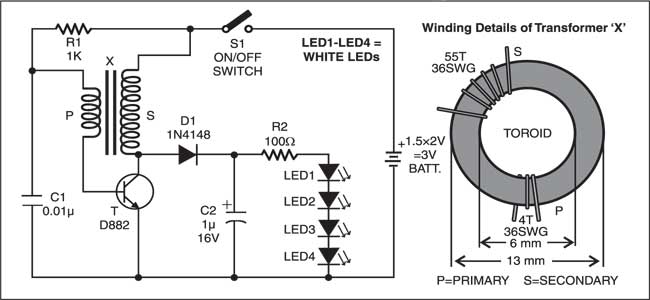 LEDs are becoming increasingly popular in many lighting applications. White LEDs are now common in torches. Here’s a simple and economical LED torch that operates off two 1.5V cells.
LEDs are becoming increasingly popular in many lighting applications. White LEDs are now common in torches. Here’s a simple and economical LED torch that operates off two 1.5V cells.
Why go for LEDs?
LEDs are ideal for use in applications that are subject to frequent on-off cycling, unlike fluorescent lamps that burn out more quickly when cycled frequently, or HID lamps that require a long time before restarting. These can very easily be dimmed or strobed. LEDs light up very quickly. A typical red indicator LED will achieve full brightness in microseconds. These mostly fail by dimming over time, rather than the abrupt burn-out of incandescent bulbs.
LEDs, being solid state components, are difficult to damage with external shock, unlike fluorescent and incandescent bulbs which are fragile. They can be very small and are easily populated onto printed circuit boards. Also LEDs do not contain mercury, unlike compact fluorescent lamps.
Not only do LEDs consume less electricity, they are also safer as LEDs are much cooler than incandescent lights, reducing the risk of combustion or burnt fingers and sturdier as LEDs are made with epoxy lenses, not glass hence are much more resistant to breakage.
LED torch circuit
For a white LED, the forward conduction voltage and the forward current are 3.6V and 20 mA, respectively. Capacitor C1, the transistor, and the transformer form a self-oscillating DC-DC converter. The transformer boosts the input battery voltage and supplies a high voltage to the white LEDs. Diode D1 and smoothing capacitor C2 supply the high voltage to the LED chain via resistor R2.

The light intensity is affected by the input battery voltage. As the transformer is not readily available in the market, you may need to build it yourself. The transformer windings also affect the light intensity. The transformer coil is wound on a 4mm thick ferrite toroid having 13mm outer diameter and 6mm inner diameter.
Primary windings comprise 4 turns and secondary windings 55 turns of 36SWG copper-enamelled wire on toroid transformer core as shown on the right side in the figure. For the long life of 1.5V cells, keep switch S1 in ‘on’ position only when the torch is in use.
The article was first published in December 2003 and has recently been updated.








